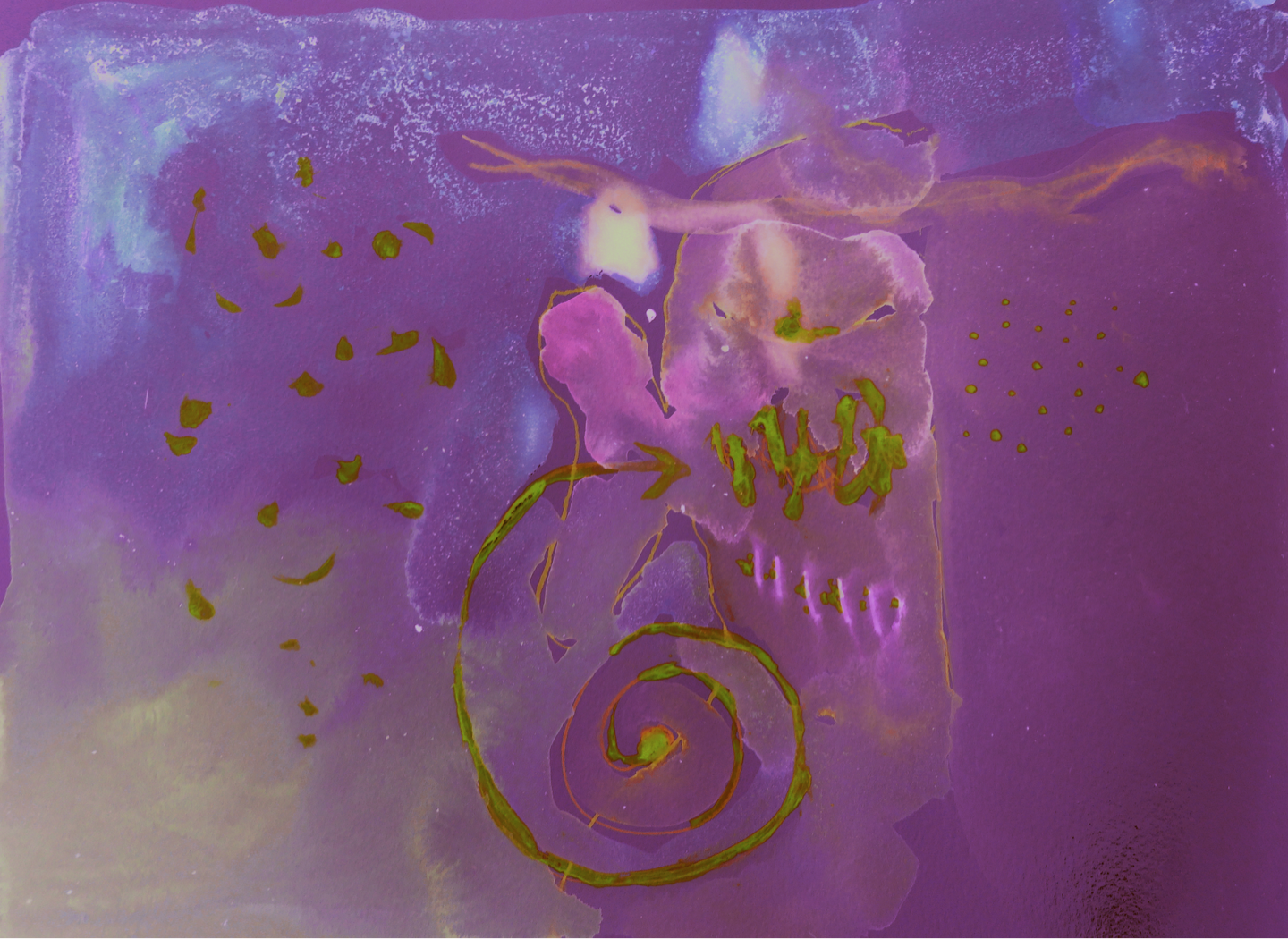Image made in response to listening to someone's experience of tinnitus
I have for some time now been making images in response to people's interoceptual experiences. Sometimes when I do this I can find myself lost in an inner sea of the body and experience it as another universe. To be lost within people's experiences, can sometimes induce a feeling within myself not unlike that one sometimes described as 'oceanic' and when that happens the resulting images can feel cosmic. The image above was a final one made in response to a series of visits to someone trying to communicate what it feels like to hear a sound that doesn't actually exist. Sometimes this was an experience inside the body, but not always, at other times the 'sound' seemed to come from outside. The 'buzz' of sound seeming to be like the sea, a sea that existed inside as well as outside the person experiencing the noise.
I'm sure most of us have at one point or another swum out a little beyond our depths when at the seaside, or on a foreign holiday found ourselves swimming in a deep clear sea on a beautiful sunny day. These can be moments when you just close your eyes and float, letting the sea take you and as you do everything seems to be in that moment, all worries and fears for once dismissed, as you experience a oneness with the moving waters, the sea sound in your ears and the sun above. This is the feeling of the oceanic.
The 'oceanic feeling' was first used as a term by Romain Rolland. De Cruz (2022) states that Sigmund Freud in response to a letter from Rolland, attempted to explain religion as the result of certain cognitive dispositions and saw it as a 'childlike yearning for a fatherly figure'. He took Rolland's idea of “oceanic feeling” (of limitlessness and being connected with the world), as a sort of phenomenological explanation of religious experience. But what if the reality of that experience is of a deeper significance, and in being reminded of how we are totally immersed and interconnected into the world, we begin to see other moments when we are totally 'lost' in our worldly integration. Higgie, (2023, p. 73), quoting Freud, writes that he also linked oceanic states to the times 'when people fall in love and consequently feel as if they are merged with another or are in some way transfigured by the experience'. Higgie (p.74) goes on to point out how Marion Milner widens Freud's vision when she writes that an oceanic state could be experienced moments of artistic creativity, when the unconscious mind lets go of the distinction between me and not me, between seer and seen, and does things that the common sense, conscious mind cannot do.'
My occasional posts on 19th century and early 20th century mystic approaches to how to visualise invisible experiences are I'm sure linked to this feeling. The moment of creativity is something special, even if we only get lost within it momentarily, in those times we let our mind/body dissolve itself into the world via the materials of making. Higgie's book reminded me of the central importance of women to a more mystic tradition of art and it has been very useful in letting me feel connected to a range of approaches to art making that have long been there and it has also reminded me that we need, as Higgie states, 'elements of illusion to cope with reality'. (Ibid, p. 88)
Image produced in response to a conversation about tinnitus
The tinnitus image above was made directly before the one that sits at the top of this post. It is easy to see the relationship and the differences. The spiral remains a very important aspect of the feeling tone but the eye has gone, it was far too obvious and grounded the image in an exterior seeing, rather than opening it out into a more 'mystic' interior life of the invisible. The colour was too predictable and had no real sense of the un-reality of an alien sound. The notes around the edge are annotations taken from a conversation made in response to a previous drawing. I listen, I draw, I take the drawing away and then develop it further. Once satisfied that I have something worthwhile, I take it back to the person I spoke to and we begin another conversation about the relationship between the image and the experience they have had. Gradually the images are changed, a type of co-production emerging. At its best when I let go of my control, an image can arrive that seems to myself at least, literally 'wonderful'.
References.
De Cruz, H. (2022) Religion and Science The Stanford Encyclopaedia of Philosophy (Fall Edition), Edward N. Zalta & Uri Nodelman (eds.), Accessed from https://plato.stanford.edu/archives/fall2022/entries/religion-science/ 15. 1. 25
Higgie, J. (2023) The Other Side: A Journey into Women, Art and the Spirit World London: Weidenfeld and Nicolson
Coda
It has been great to be chosen as one of the best drawing blogs out there by Feedspot: See: https://bloggers.feedspot.com/
See also:
Art therapy and perceptual research


No comments:
Post a Comment